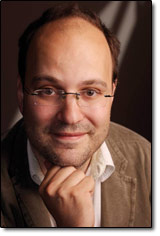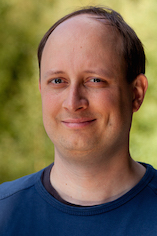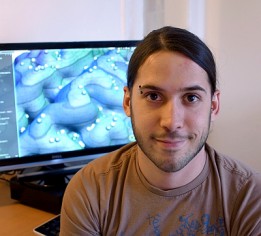During the SMI 2015 conference, three invited speakers will present their works:
- Bruno Lévy, Senior Researcher (Directeur de recherche), INRIA, France
Optimal Transport for Shape Modeling and Computer Graphics - Michael Wand, Professor, University of Mainz, Germany
Shape modeling with building blocks - Julien Tierny, Researcher, CNRS, France
Topological Data Analysis for Scientific Visualization: Where we stand and where to go.
A tutorial is also proposed during the SMI 2015 conference:
- Ergun Akleman, Professor, Texas A&M University, USA
Applications of Topological Graph Theory in Shape Modeling
 Bruno Levy is a senior researcher with Inria, and the head of the ALICE group (geometry processing and computer fabrication) that he created in 2004 (now 8 faculties). He received the Inria/French Academy of Sciences young researcher award in 2011. He is associate editor for IEEE TVCG and Graphical Models. He was paper co-chair of Eurographics 2014, Pacific Graphic 2013, SGP 2010, SPM 2008 and 2007. His main research topic is geometry processing. In the past, he focused on mesh parameterization, texture mapping and conversion between representations (e.g. mesh to Splines). More recently, in the frame of his ERC projects GOODSHAPE and VORPALINE, he worked on sampling (vector quantization) and meshing (isotropic, anisotropic, hex-dominant mesh generation). His latest research concerns efficient numerical algorithms for solving partial differential equations (such as Monge-Ampere involved in optimal transport) and practical algorithms for computational geometry (robust predicates, anisotropic Voronoi diagrams in high dimensions).
Bruno Levy is a senior researcher with Inria, and the head of the ALICE group (geometry processing and computer fabrication) that he created in 2004 (now 8 faculties). He received the Inria/French Academy of Sciences young researcher award in 2011. He is associate editor for IEEE TVCG and Graphical Models. He was paper co-chair of Eurographics 2014, Pacific Graphic 2013, SGP 2010, SPM 2008 and 2007. His main research topic is geometry processing. In the past, he focused on mesh parameterization, texture mapping and conversion between representations (e.g. mesh to Splines). More recently, in the frame of his ERC projects GOODSHAPE and VORPALINE, he worked on sampling (vector quantization) and meshing (isotropic, anisotropic, hex-dominant mesh generation). His latest research concerns efficient numerical algorithms for solving partial differential equations (such as Monge-Ampere involved in optimal transport) and practical algorithms for computational geometry (robust predicates, anisotropic Voronoi diagrams in high dimensions).
Optimal Transport for Shape Modeling and Computer Graphics
In this talk, I will present an introduction to Optimal Transport. I will also show some of its applications in Shape Modeling, as well as some numerical methods to implement it on a computer.
Optimal Transport is an elegant theory that studies a certain class of optimization problems. Recent results (due to Brenier, Benamou, Alexandrov, Aurenhammer, Merigot, Cuturi, Peyré, Thibert, …) let envision new numerical solution mechanisms that make it possible for the first time to compute it in practice. Similarly to the Fast Fourier Transform that made spectral analysis usable in numerical sciences and engineering, the recent advances that make Optimal Transport computation tractable potentially have a considerable impact on a wide class of applications. This comprises 3D morphing/matching, reflector/refractor design, reconstruction of the early state of the universe from observed galaxy clusters, and more generally, new solvers for a certain class of equations.
I will show that by using a combination of graphical representations with basic notions from linear algebra, it is possible to translate some of the abstract concepts of Optimal Transport into more intuitive ones, and thus grasp an intuition of both the theory and several numerical algorithms that implement it.
The presentations will be illustrated with several videos and live demos. Some of the algorithms are available in the Geogram programming library.
 Michael Wand is a professor at the Institute of Computer Science at University of Mainz. Before that, he has worked at the Department of Information and Computing Sciences at Utrecht University, at the Max-Planck Institute for Informatics and Saarland University in Saarbrücken, and has visited Stanford University as a postdoc. He has received a Ph.D. in computer science from University of Tübingen in 2004 and a diploma degree in computer science from University of Paderborn in 2000.
Michael Wand is a professor at the Institute of Computer Science at University of Mainz. Before that, he has worked at the Department of Information and Computing Sciences at Utrecht University, at the Max-Planck Institute for Informatics and Saarland University in Saarbrücken, and has visited Stanford University as a postdoc. He has received a Ph.D. in computer science from University of Tübingen in 2004 and a diploma degree in computer science from University of Paderborn in 2000.
Shape modeling with building blocks
One of the big contemporary research challenges in our field is to discover structure in shapes and to utilize it for modeling. In this talk, I would like to discuss a class of methods that organize shapes via “building blocks” in order to provide new structure-aware modeling tools.
Building blocks are pieces of geometry that are reused repeatedly in order to form a composite shape (building blocks are maximal pieces that are always reused as a whole). The notion of building blocks is tightly coupled to shape matching (correspondences) and symmetry, which has to be elucidated first.
The prime application of building block methods is “inverse procedural modeling”: Given a piece of example geometry, we would like to learn sets of rules that characterize shape variants that are structurally similar to the example data. Building blocks provides a model for characterizing “locally similar” shapes, i.e., local neighborhoods are supposed to be indistinguishable from matching parts of the example data. Further, it gives insights in the computational complexity involved: While inferring general shapes with local similarity turns out to be undecidable, we can find restricted subclasses (again, based on various symmetry arguments) that can be handled very efficiently.
Finally, while the approach considered so far assumes clean geometry with perfect matching information, building blocks can also be used to structure ambiguous data: When shape matching becomes unreliable due to noise or the usage of ambiguous similarity cues, the notion of building block consistency can act as additional regularizer for unsupervised discovery of structure, which, in turn, can again be used to aid semi-automatic modeling based on real-world example data.
 Julien Tierny received the Ph.D. degree in Computer Science from Lille 1 University in 2008. He is currently a CNRS permanent researcher, affiliated with Sorbonne Universities (LIP6, UPMC Paris 6, France) since September 2014 and with Telecom ParisTech from 2010 to 2014. Prior to his CNRS tenure, he held a Fulbright fellowship (U.S. Department of State) and was a post-doctoral research associate at the Scientific Computing and Imaging Institute at the University of Utah. His research interests include topological and geometrical data analysis for scientific visualization and graphics. He served as a program committee member for several international conferences of the field.
Julien Tierny received the Ph.D. degree in Computer Science from Lille 1 University in 2008. He is currently a CNRS permanent researcher, affiliated with Sorbonne Universities (LIP6, UPMC Paris 6, France) since September 2014 and with Telecom ParisTech from 2010 to 2014. Prior to his CNRS tenure, he held a Fulbright fellowship (U.S. Department of State) and was a post-doctoral research associate at the Scientific Computing and Imaging Institute at the University of Utah. His research interests include topological and geometrical data analysis for scientific visualization and graphics. He served as a program committee member for several international conferences of the field.
Topological Data Analysis for Scientific Visualization: Where we stand and where to go.
Scientific Visualization aims at helping users represent, explore, analyze and interpret simulated or acquired geometrical data. Among existing techniques, algorithms inspired by Morse theory have demonstrated their effectiveness to capture and summarize the structure of the studied phenomena. In this setting, the data is typically represented by a piecewise-linear scalar field defined over a triangulation, whose critical points often correspond to features of interest application-wise: center of atoms and bonds in chemistry, vortices in computational fluid dynamics, flames in combustion, etc. Then, constructions such as the Reeb graph or the Morse-Smale complex can encode at multiple scales the structural relation between the features of interest of the data.
In this talk, I will present a brief tutorial and state-of-the-art on the computational techniques for the topological analysis of scientific data. The core intuitions of Morse theory and persistent homology will be discussed. Efficient algorithms for data segmentation (based on the Reeb graph and the Morse-Smale complex) will be presented and their utility will be illustrated with specific use cases. In a second part, I will discuss practical challenges that recently arose with the rapid development of high performance computing resources, which does not only yield data-sets of unprecedented size, but also new types of data such as uncertain scalar fields. These difficulties are not only exciting for the research community because of their practical importance, but also because they require a complete reboot of the research effort that has been achieved in this area over the last twenty years. In particular, I will present recent results for the topological analysis of uncertain data and premises in the analysis of multi-variate data.
 Dr. Ergun Akleman is a Professor in the Department of Visualization who is Joint Appointed with Computer Science and Engineering Department at Texas A&M University. He received his Ph.D. degree in Electrical and Computer Engineering from the Georgia Institute of Technology in 1992. He is also a professional cartoonist, illustrator and caricaturist who have published more than 500 cartoons, illustrations and caricatures. His research work is interdisciplinary, usually motivated by aesthetic concerns. He has published more than 125 technical papers in the areas of shape modeling, image synthesis, artistic depiction, image based lighting, texture and tiles, computer aided caricature, electrical engineering and computer aided architecture. His most significant contributions have been in shape modeling and computer aided sculpting. His work on a topological mesh modeling has resulted in a powerful manifold mesh modeling system, called TopMod. The initial version of the software, TopMod has been available as free software for almost 10 years. Many talented artists created very interesting sculptures using TopMod. Dr. Akleman, with researchers from University of Houston, also designed a popular IPhone Health and Fitness application, called Walk’N Play. His teaching is also interdisciplinary by nature and innovative. In the Visualization department, he teaches a wide variety of topics in covering both artistic and scientific aspects of computer graphics. He combines a studio approach with lectures. In his art and design courses, students also learn mathematics. In his technical computer graphics courses that are usually heavy in computer science and mathematics, students also learn aesthetics aspects of the subject.
Dr. Ergun Akleman is a Professor in the Department of Visualization who is Joint Appointed with Computer Science and Engineering Department at Texas A&M University. He received his Ph.D. degree in Electrical and Computer Engineering from the Georgia Institute of Technology in 1992. He is also a professional cartoonist, illustrator and caricaturist who have published more than 500 cartoons, illustrations and caricatures. His research work is interdisciplinary, usually motivated by aesthetic concerns. He has published more than 125 technical papers in the areas of shape modeling, image synthesis, artistic depiction, image based lighting, texture and tiles, computer aided caricature, electrical engineering and computer aided architecture. His most significant contributions have been in shape modeling and computer aided sculpting. His work on a topological mesh modeling has resulted in a powerful manifold mesh modeling system, called TopMod. The initial version of the software, TopMod has been available as free software for almost 10 years. Many talented artists created very interesting sculptures using TopMod. Dr. Akleman, with researchers from University of Houston, also designed a popular IPhone Health and Fitness application, called Walk’N Play. His teaching is also interdisciplinary by nature and innovative. In the Visualization department, he teaches a wide variety of topics in covering both artistic and scientific aspects of computer graphics. He combines a studio approach with lectures. In his art and design courses, students also learn mathematics. In his technical computer graphics courses that are usually heavy in computer science and mathematics, students also learn aesthetics aspects of the subject.
Applications of Topological Graph Theory in Shape Modeling
In this 3-hour tutorial, I will present a topological graph theory based framework to represent all topologically distinct shapes in 3D, from solids to surfaces and curves. I will present how this unifying framework can be used to build a universal and modular system for the visualization, design, and construction of shapes, amenable to a broad range of science, engineering, architecture, and design applications. I will, in particular, provide a practical perspective that can demonstrate the progress that naturally resulted from the emergence of 3D Graph Rotation Systems. I will start with demonstrating natural correspondences with existing mesh data structures by providing hands-on and computer experiments. I will then build more complicated concepts and ideas again with hands-on and computer experiments. Using experiments that provide strong insight for underlying ideas and concepts will make the tutorial accessible to anybody who has basic mathematics background but with no background knowledge.